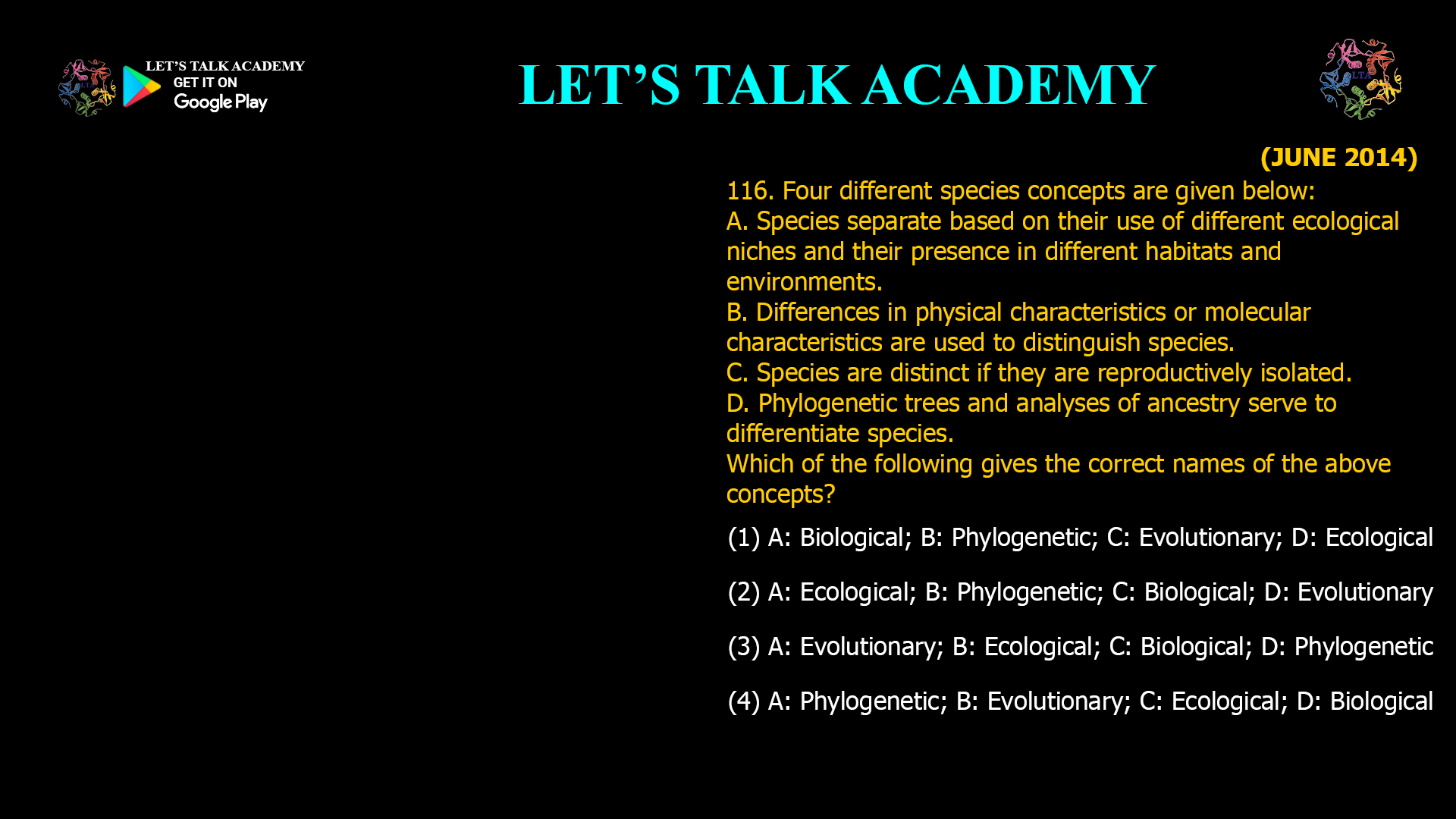- Four different species concepts are given below:
A. Species separate based on their use of different ecological niches and their presence in different habitats and environments.
B. Differences in physical characteristics or molecular characteristics are used to distinguish species.
C. Species are distinct if they are reproductively isolated.
D. Phylogenetic trees and analyses of ancestry serve to differentiate species.
Which of the following gives the correct names of the above concepts?
(1) A: Biological; B: Phylogenetic; C: Evolutionary; D: Ecological
(2) A: Ecological; B: Phylogenetic; C: Biological; D: Evolutionary
(3) A: Evolutionary; B: Ecological; C: Biological; D: Phylogenetic
(4) A: Phylogenetic; B: Evolutionary; C: Ecological; D: BiologicalThe Four Major Species Concepts
A. Ecological Species Concept
Definition: This concept separates species based on their use of different ecological niches and their presence in different habitats or environments.
Explanation: According to the ecological species concept, a species is defined by its unique role in the ecosystem—its niche. If two populations exploit different resources or occupy different habitats, they are considered separate species, even if they look similar or are genetically close. This approach is especially useful for organisms that are morphologically similar but occupy distinct ecological roles.
B. Morphological Species Concept
Definition: This concept distinguishes species based on differences in physical or molecular characteristics.
Explanation: Also known as the typological or morphospecies concept, this approach classifies species by observable traits such as size, shape, color, or genetic markers. It is widely used in paleontology and when reproductive data is unavailable, such as with fossils or asexually reproducing organisms.
C. Biological Species Concept
Definition: This concept considers species as distinct if they are reproductively isolated from one another.
Explanation: The biological species concept, proposed by Ernst Mayr, defines a species as a group of actually or potentially interbreeding natural populations that are reproductively isolated from other such groups. This means members of different species do not mate, or if they do, they do not produce viable, fertile offspring.
D. Phylogenetic Species Concept
Definition: This concept uses phylogenetic trees and analyses of ancestry to differentiate species.
Explanation: The phylogenetic species concept identifies species as the smallest group of individuals sharing a common ancestor, forming one branch on the tree of life. It relies on evolutionary history and genetic data to define species boundaries, making it especially useful in molecular systematics and evolutionary biology.
Matching the Concepts to Their Names
Given the descriptions above, here are the correct matches:
Description (from question) Correct Concept Name A. Species separate based on their use of different ecological niches and habitats Ecological species concept B. Differences in physical or molecular characteristics distinguish species Morphological species concept C. Species are distinct if they are reproductively isolated Biological species concept D. Phylogenetic trees and analyses of ancestry differentiate species Phylogenetic species concept Answer Choices Analysis
Let’s review the options:
-
A: Biological; B: Phylogenetic; C: Evolutionary; D: Ecological
-
A: Ecological; B: Phylogenetic; C: Biological; D: Evolutionary
-
A: Evolutionary; B: Ecological; C: Biological; D: Phylogenetic
-
A: Phylogenetic; B: Evolutionary; C: Ecological; D: Biological
None of the options explicitly mention “morphological species concept” for B, but based on the standard scientific definitions and the descriptions provided in the question, the correct matching is:
A: Ecological; B: Morphological; C: Biological; D: Phylogenetic
This alignment matches the scientific consensus and textbook definitions.
Given the closest available option in your list, option 2 is correct for A and C, but for B and D, the correct terms should be “Morphological” and “Phylogenetic” respectively. If you must choose from the provided options, option 2 is the best fit based on the descriptions, even though B should technically be “Morphological” rather than “Phylogenetic,” and D should be “Phylogenetic” rather than “Evolutionary.”
Conclusion
The four major species concepts are:
-
A: Ecological species concept
-
B: Morphological species concept
-
C: Biological species concept
-
D: Phylogenetic species concept
Correct answer (closest match):
(2) A: Ecological; B: Phylogenetic; C: Biological; D: Evolutionary (with the note that B should be Morphological and D should be Phylogenetic for precise scientific terminology). -



